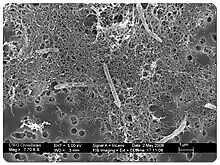Candidatus Desulforudis audaxviator
| Desulforudis audaxviator | |
|---|---|
 | |
| Desulforudis audaxviator | |
| Scientific classification | |
| Domain: | |
| Phylum: | |
| Class: | |
| Order: | |
| Family: | |
| Genus: | Desulforudis |
| Species: | Candidatus D. audaxviator |
| Binomial name | |
| Desulforudis audaxviator | |
"Candidatus Desulforudis audaxviator" is a monospecific genus of bacteria that lives in groundwater at depths from 1.5–3 kilometres (0.93–1.86 mi) below the Earth's surface.
Etymology
The name comes from a quotation from Jules Verne's novel Journey to the Center of the Earth, where the hero, Professor Lidenbrock, finds a secret inscription in Latin: Descende, audax viator, et terrestre centrum attinges (Descend, bold traveller, and you will attain the center of the Earth).[1]
Biology
Desulforudis audaxviator is the only bacterium found in water samples obtained 2.8 kilometres (1.7 mi) underground in the Mponeng gold mine in South Africa.[2] Approximately four micrometres in length, it survives on chemical food sources derived from the radioactive decay of minerals in the surrounding rock. This makes it one of the few known organisms that does not depend on sunlight for nourishment, and the only species known to be alone in its ecosystem.[1] It has genes for extracting carbon from dissolved carbon dioxide and for nitrogen fixation. It may also have acquired genes from a species of archaea by horizontal gene transfer.[2]
Analyses of water from the bacteriums' habitat show that the water is very old and has not been diluted by surface water, indicating the bacterium have been isolated from Earth's surface for several million years.[3] As the environment at that depth is so much like the early Earth, it may indicate what types of creatures existed before there was an oxygen atmosphere. Billions of years ago, some of the planet's first bacteria may have thrived in similar conditions. The newly discovered microbes could shed light on the origins of life on Earth.
"Ca. D. audaxviator" is a Gram positive sulfate-reducing bacterium (making it the first complete such genome). The genome contains an unusual transposon and possesses many sites of insertion. Its complete intolerance of oxygen suggests long-term isolation. The hydrocarbons in that environment do not come from living organisms. The source of the hydrogen needed for their respiration comes from the decomposition of water by radioactive decay of uranium, thorium and potassium. The radiation allows for the production of sulphur compounds the bacteria can use as a high-energy food source.
"Ca. D. audaxviator" not only survives in a complete absence of organic compounds, light, and oxygen, but also in temperatures as high as 60 °C (140 °F) and a pH of 9.3. The physiology that enables it to live in these extreme conditions is a tribute to its unusually large genome, consisting of 2157 genes instead of the 1500 of its peers. If conditions become unfavorable for normal life, "Ca. D. audaxviator" is able to encyst, safeguarding its DNA from heat, extreme pH, and the lack of water.[4]
A 2021 study reported further findings in West Siberia as in Death Valley, California.[5][6]
See also
- List of sequenced archaeal genomes
- AngloGold Ashanti, operator of the Mponeng gold mine
Notes
- 1 2 Eliza Strickland (2008-10-10). "Deep in a Goldmine, an Ecosystem of One". Discover magazine. Retrieved 2008-10-10.
- 1 2 Catherine Brahic. "Goldmine bug DNA may be key to alien life". New Scientist. Retrieved 2008-10-11.
- ↑ "At 2.8 km down, a 1-of-a-kind microorganism lives all alone". Phys.Org. 2008-10-09. Retrieved 2013-01-21.
- ↑ "Desulforudis audaxviator". Archived from the original on 2016-03-26. Retrieved 2011-11-27. (dead link 12 June 2018)
- ↑ Becraft, Eric D.; Lau Vetter, Maggie C. Y.; Bezuidt, Oliver K. I.; Brown, Julia M.; Labonté, Jessica M.; Kauneckaite-Griguole, Kotryna; Salkauskaite, Ruta; Alzbutas, Gediminas; Sackett, Joshua D.; Kruger, Brittany R.; Kadnikov, Vitaly; van Heerden, Esta; Moser, Duane; Ravin, Nikolai; Onstott, Tullis; Stepanauskas, Ramunas (October 2021). "Evolutionary stasis of a deep subsurface microbial lineage". The ISME Journal. 15 (10): 2830–2842. doi:10.1038/s41396-021-00965-3. PMC 8443664. PMID 33824425. Lay summary.
{{cite journal}}: Cite uses deprecated parameter|lay-url=(help) - ↑ "Microbe in Evolutionary Stasis for Millions of Years - Bigelow Laboratory for Ocean Sciences". Bigelow. 8 April 2021.
References
| Wikimedia Commons has media related to Desulforudis audaxviator. |
- Dylan Chivian; Eoin L. Brodie; Eric J. Alm; et al. (10 October 2008). "Environmental genomics reveals a single-species ecosystem deep within the Earth" (PDF). Science. 322 (5899): 275–278. Bibcode:2008Sci...322..275C. doi:10.1126/science.1155495. PMID 18845759. S2CID 8337095.